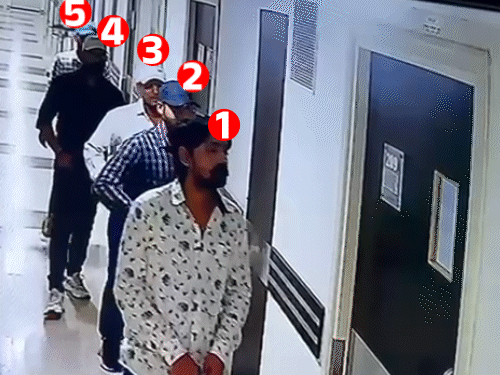Bihar’s Bloody Monsoon: Where Hospitals Become Killing Fields and Police Offer Absurd Excuses
This is not a scene from Gangs of Wasseypur or Mirzapur. This is Bihar. The real Bihar. A place where crime is unfolding at such a terrifying pace that even OTT thriller makers would be left speechless.
Recently, a horror episode unfolded at Paras Hospital in Patna. A place built to save lives turned into a killing field when five armed men stormed Room 209 in broad daylight. Faces uncovered, guns blazing, they walked in and executed their target within 25 seconds, leaving the hospital echoing with gunshots and screams. There was no panic in their gait – they were unafraid. They didn’t hide their guns, nor did anyone try to stop them entering or leaving. It was as if the rule of law had ceased to exist.

This wasn’t fiction. This was Bihar’s truth, screaming that murder here is no big deal anymore. In just the last 15 days, over 50 murders have been reported – an average of three deaths per day. This monsoon, blood has flowed more freely than rain. Yet, the administration’s explanation is even more shocking than the killings themselves.
A senior police officer bizarrely said, “Farmers are idle in these months. When they have no work in June-July, crime increases.” Think about it. The people who feed this nation, who battle drought, floods, debt, and poverty to grow our crops, are casually branded as murderers by the state. It is an insult of unimaginable magnitude.
But let’s come back to the incident. The man killed in Paras Hospital was Chandan Mishra, himself a dreaded criminal out on parole. His killers walked in like actors shooting an action scene, pumped bullets into him, and left unhindered. CCTV footage showed their fearless faces. Police later said, “He was a criminal killed in gang war.” As if to say: it doesn’t matter. As if Bihar’s police force has surrendered to crime. As if they are saying, “Gang wars happen. So what?”
This is the reality of Bihar today – a place that has turned from a state into a shooting range. Where bullets speak louder than the law. Where human life is worth just one bullet.

Bihar Police claim crime has reduced this year compared to last year. But reality defies their statistics. From January to June 2025 alone, 10,376 murders have occurred – an average of 29 murders per month. In the last 17 days, over 50 people have been killed. And these are not just criminals or poor people. Everyone is vulnerable. In early July, prominent businessman Gopal Khemka was shot dead in Patna. His murder came despite him knowing his life was in danger and despite police knowing he was under threat. Seven years ago, his elder son was also murdered. Yet, no protection, no justice. His death showed that in Bihar, neither wealth nor influence can save you.
The list of killings is long and horrifying:
July 3: Vegetable seller Dinesh Das and his wife murdered over land dispute.
July 4: Businessman Gopal Khemka shot dead in Patna.
July 6: School director Ajit Kumar killed in Danapur; five of a family butchered in Purnia; two murdered in Nalanda.
July 7: Farmer Badri Yadav murdered in Madhubani; Surendra Jha shot dead in Vaishali.
July 10: Sand trader Ramakant Yadav killed in Patna; Shiv Nandan murdered in Jehanabad; elderly woman killed in Samastipur.
July 11: Lawyer Jitendra Mahto killed in Patna; a trader in Sitamarhi; teacher in Chhapra murdered.
July 15: 16-year-old girl murdered in Nawada.
These are just a few names in a never-ending list. And the horror doesn’t end on the streets. It thrives inside Bihar’s jails too. Take Beur Jail in Patna – the state’s most notorious prison, dubbed Bihar’s Tihar. It houses over 4500 inmates and has turned into a command centre for gangsters. They run extortion rackets from their cells using smuggled smartphones, SIM cards, and data cables. They threaten businessmen, demand protection money, and order murders. If someone refuses, they’re executed.
In January this year, the jail superintendent’s residence was raided after allegations surfaced of bribes taken to provide special treatment to inmates. Officials were suspended. But the racket never stopped. Because when gangsters can become MLAs, MPs, and ministers, what hope remains for systemic reform?
Across India, 46% of MPs elected in the last Lok Sabha had criminal cases against them. Thirty-one faced charges of murder, rape, or kidnapping. When lawmakers themselves come from jails, what motivation exists to clean up prisons or control crime?
Meanwhile, Bihar’s Additional Director General of Police, Kundan Krishnan, crossed all limits of absurdity by blaming farmers for crime. “In May-June, farmers have no work. So crime increases.” The police force, instead of accepting administrative failures, pointed fingers at the very community that keeps India fed. It is an insult beyond measure.
And what of Paras Hospital, where bullets rained on ICU beds? Hospitals are supposed to be sacred, safe spaces. The ease with which armed men walked in and executed a killing shows that the criminals of Bihar fear no one – not the law, not the police, not society. Their open, unmasked faces were not a mistake. It was a message: We own this place. We do what we want.
Bihar today is an open-air theatre of blood and impunity. Its political class remains largely silent. Its police force appears to have accepted defeat. Its prisons are command centres for crime syndicates. And its people are left clutching their heads, asking: Where do we go? Who will save us?
The government touts NCRB data showing crime has fallen. But ask the families mourning their loved ones, the traders paying extortion money, the farmers threatened by mafias, or the children who cannot sleep at night because gunshots echo through their streets – numbers don’t matter when death is so near.
As Adama Gondvi once wrote, “In your files, the village is blooming. But these claims are false and these promises are just words.” Bihar’s statistics might claim improvement, but its reality is drenched in blood, fear, and systemic failure.
This monsoon, rain clouds gather over Bihar. But they carry no relief. They carry an ominous reminder – that here, bullets pour down heavier than rain, and human life costs no more than a trigger pull.
Until the administration wakes up from its stupor, until criminals are no longer worshipped as leaders, and until prisons stop being offices for gangster empires, Bihar will remain what it is today:
A state drowning in its own blood.
A shooting range.
A place where death is a statistic and justice is a myth.
News
Ibrahim Ali Khan Unleashes a Fierce New Avatar in Sarzameen: Fans Stunned by His Dramatic Transformation and Intense Action Training
Ibrahim Ali Khan Unleashes a Fierce New Avatar in Sarzameen: Fans Stunned by His Dramatic Transformation and Intense Action Training…
Sanjeeda Shaikh: Behind The Controversies That Shattered Her Perfect Image
Sanjeeda Shaikh: Behind The Controversies That Shattered Her Perfect Image Whenever controversies in the entertainment world are discussed, one name…
Inside Jannat Zubair and Mr. Faisu’s Alleged Breakup: Fame, Family, and Hidden Truths
Inside Jannat Zubair and Mr. Faisu’s Alleged Breakup: Fame, Family, and Hidden Truths For years, fans adored their chemistry, prayed…
Kabir Bedi Opens Up About His Fourth Marriage, Daughter Pooja’s Anger, and Healing Years of Family Rift
Kabir Bedi Opens Up About His Fourth Marriage, Daughter Pooja’s Anger, and Healing Years of Family Rift Veteran Bollywood actor…
Ranveer Singh Heartbroken as Sanjay Leela Bhansali Chooses Ranbir Kapoor Over Him: A Friendship Ends in Bollywood
Ranveer Singh Heartbroken as Sanjay Leela Bhansali Chooses Ranbir Kapoor Over Him: A Friendship Ends in Bollywood In an unexpected…
End of content
No more pages to load












